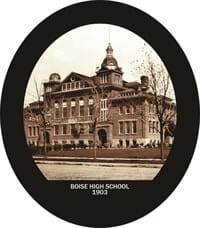 Honoring Boise High School
Honoring Boise High School
Students, Alumni, Faculty and Staff
Central School, built in Boise in 1882, was one of only two schools in Idaho Territory serving high school students, but after statehood in 1900, the booming Treasure Valley required a dedicated high school, so Boise School District #1 purchased a square block on Washington Street. The cornerstone for the new “Boise High School” was laid in 1902. It was not the white brick building present today, but a traditional red brick structure, typical of the period.
When the two-story school opened, board members asserted it was large enough to serve Boise for all time. At the joyous ceremony, Mayor Moses Alexander stated Boise High School was “where the rich and the poor meet on terms of equality.” The pageant included 1,200 students, as many adults and three volleys from the Cadet Corps.
Military training for high school students had begun in 1900. The students, with the superintendent’s support, had organized the Boise High Cadets, and when their request for federal funding was turned down, they had purchased their own uniforms and some equipment. They also encouraged an NCO from the Boise Barracks to drill them several times a week. The group grew from 30-40 members in 1900 to 70 in 1902.
The school board minutes of Aug. 4, 1903, listed this classical curriculum for the 1903-1904 school year:
- 9th grade: Algebra, American Literature, Civics, Physical Geography, and English Grammar or Latin
- 10th grade: Algebra, Rhetoric, History, Zoology, and Botany or Caesar
- 11th grade: English Literature, Physics, Plane Geometry, Astronomy, and English History or Cicero
- 12th grade: Chemistry, Geology, Solid Geometry, American History, Economics, Advanced Arithmetic, and Critical Literature or Virgil
Courses added between 1904 and 1908 included cooking, sewing, manual training and music. Marguerite Nolan (Mrs. Herbert Lemp) is credited with beginning the domestic science courses at Boise High. From 1908-1915, the home economics program and the manual arts program were enlarged in scope and accommodated in two new wings, added in 1908 and 1912, that had a more modern design and a white brick exterior.
Other curriculum changes included the first free night school for high school dropouts and the addition of stenography and typewriting.
In 1919, the Industrial Arts Building was constructed adjacent to the main building. It housed the print shop, where much of the school district's printing was done for half a century.
The red brick section was replaced with a white brick structure in 1922, its entry flanked by huge columns. It had a basement, three floors and a state-of-the-art auditorium used by both the school and the community. WPA labor erected a new gymnasium in 1936. Students donated nickels and dimes to cover some of its costs. It replaced the cracker box gym in the basement of the main building, which had a ceiling so low it interfered with playing basketball.
In 1957, a new music building was added on the west side of the gym. In the early 1960s, land two blocks west of the main campus became an athletic complex for football, track and tennis. When Boise High's population exploded in the late 1980s, enrollment was closed for some classes.
As the main building began to show its age, the School District Board of Trustees considered replacing the school. Public debate raged for almost three years; a bond issue that would have refurbished the high school failed in 1993. However, in 1995, the Board voted to run another bond for the construction of two new junior highs, two new elementary schools and the improvement of many buildings. This bond passed, with over 70 percent of electors voting yes. It funded Timberline High School as well as a massive renovation of Boise High School that razed three structures and vacated a city street. Americans with Disabilities Act (ADA) accessibility improvements were made, an art gallery was created and the auditorium was completely restored. The third floor was closed off and air conditioning was installed building-wide. The Frank Church Building of Technology, named after Idaho’s U.S. Senator and 1942 Boise High graduate, was also completed.
Read more about Boise High School.
Donors:
William Johnson
Sharon Lawrence
Irene Dunn
Gary Pridmore
Charles and Francis Clifton
Roger and Virginia Allen
Roy Crawford
Gerald and Holly McDaniel
Elizabeth Lawson
Paul and Ferne Bockmann
Phyllis Richeson
Ferris and Lorraine Dracobly
Ann Samuelson
Roberta and Douglas Yeaman
Dennis Jones
Cindy Schaffeld- IMO Fran Uberuaga